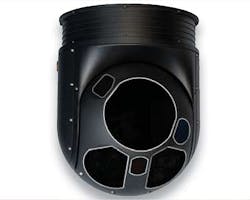FLIR Systems to provide Star Safire 380 thermal imaging systems to Austrian military
ABERDEEN PROVING GROUND, Md., 29 July 2014. Surveillance and reconnaissance experts in the Austrian military needed long-range high-definition thermal imaging systems for a variety of intelligence applications. They found their solution from FLIR Systems Inc. in Wilsonville, Ore.
Officials of the U.S. Army Contracting Command at Aberdeen Proving Ground, Md., on Monday awarded a $7.2 million contract to FLIR Systems to provide seven of the company's Star Safire 380 thermal imaging systems in a foreign military sales contract to Austria.
The long-range FLIR Star SAFIRE 380-HD electro-optical system combines color daylight digital camera and medium-wave infrared (MWIR) thermal-imaging camera in a motion-stabilized pod that is hardened for military fixed-wing aircraft, helicopters, aerostats, and other kinds of aircraft. The Star SAFIRE 380-HD, which has an optional shortwave infrared (SWIR) camera and laser rangefinder, illuminator, and pointer, embeds metadata in its video stream.
The optional SWIR sensor in the Star SAFIRE 380-HD provides expanded multi-spectral day and night imaging with high definition mega-pixel resolution imagery. SWIR sensors can detect light from just beyond what the human eye can see to where infrared thermal imagers can perceive, and has the ability to see through windows and other kinds of glass, unlike medium- or long-wave infrared thermal imaging sensors.
Related: Army chooses electro-optical sensors from FLIR for Persistent Ground Surveillance Systems
SWIR light wavelengths are from 0.9 to 1.7 microns, and are reflective light, so its imagery has shadows and contrast. Since SWIR images are not in color, objects are easily to recognize. One big advantage of SWIR imaging sensors is their ability to use night sky radiance, which emits five to seven times more illumination than starlight -- nearly all of it in the SWIR wavelengths. As a result, SWIR imaging sensors use this night radiance to reveal objects clearly on moonless nights.
The FLIR Systems Star Safire 380 thermal-imaging pod is for applications in intelligence, surveillance, and reconnaissance (ISR); search and rescue; maritime patrol; border patrol, unmanned aerial vehicles (UAVs); and force protection, FLIR officials say.
The thermal imager is an all-digital, full HD system in one line-replaceable unit. It has high-bandwidth HD-SDI video channels with symbology overlays that comply with government HD standards, providing 1080-pixel, 720-pixel, and other formats.
Related: FLIR Systems to design thermal imaging sensors for Navy and Coast Guard patrol boats
Sensor and geospatial data is embedded within the digital video stream, and the unit offers expanded multi-spectral imaging, with extended color imaging into the dark, and the unit can view, track, and mark ground locations using its embedded inertial measurement unit.
The Star 380 can follow moving targets with its multi-mode autotracker, and can illuminate wide areas covertly. It also can point out distant targets to other forces, and determine target distance and location. The thermal imager's all-weather design is qualified to MIL-STD-810 and 461, FLIR officials say.
On this contract FLIR Systems will do the work in Wilsonville, Ore., and should be finished by August 2016. For more information contact FLIR Systems online at www.flir.com, or the Army Contracting Command at Aberdeen Proving Ground at www.acc.army.mil/contractingcenters/acc-apg.

